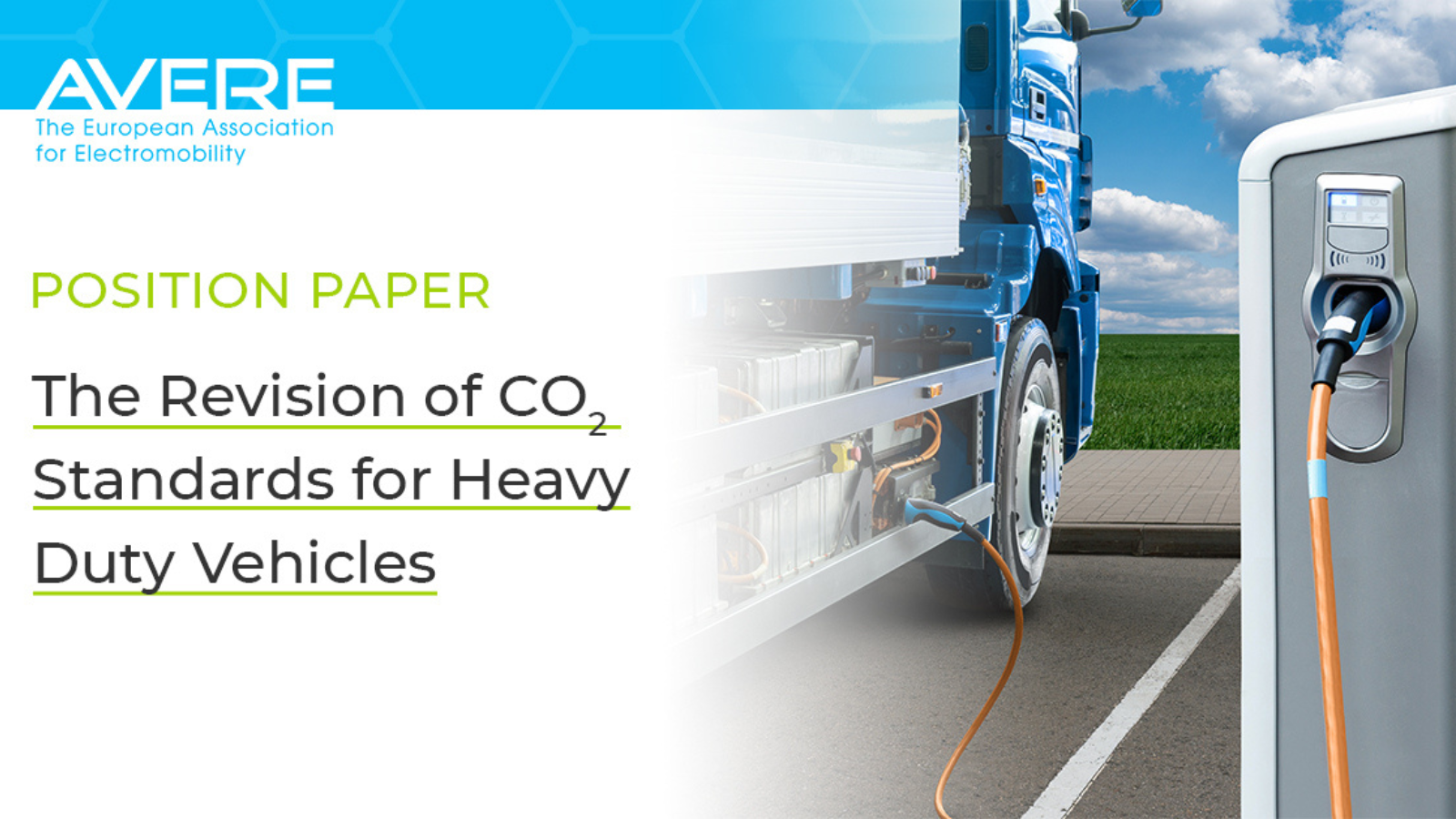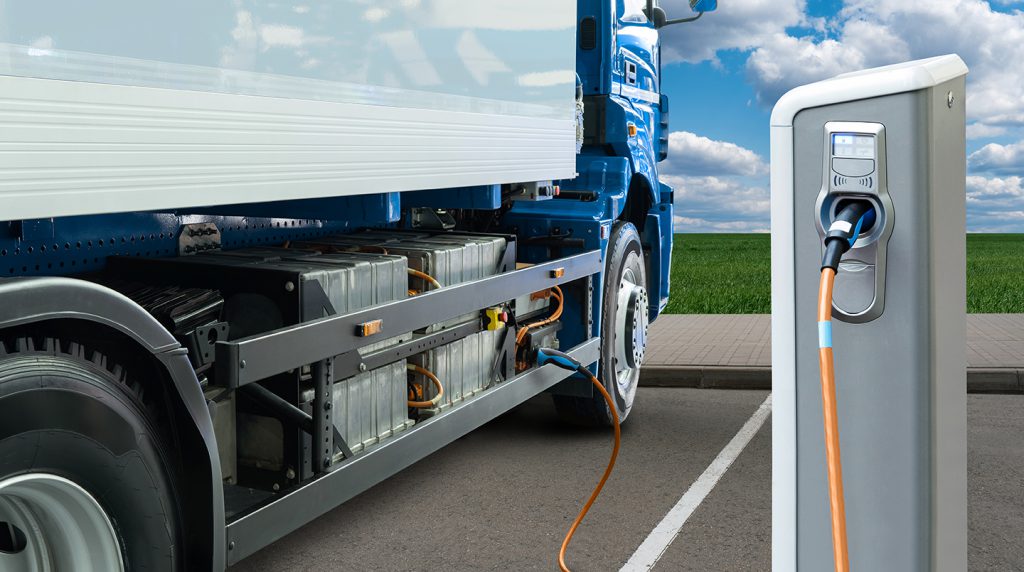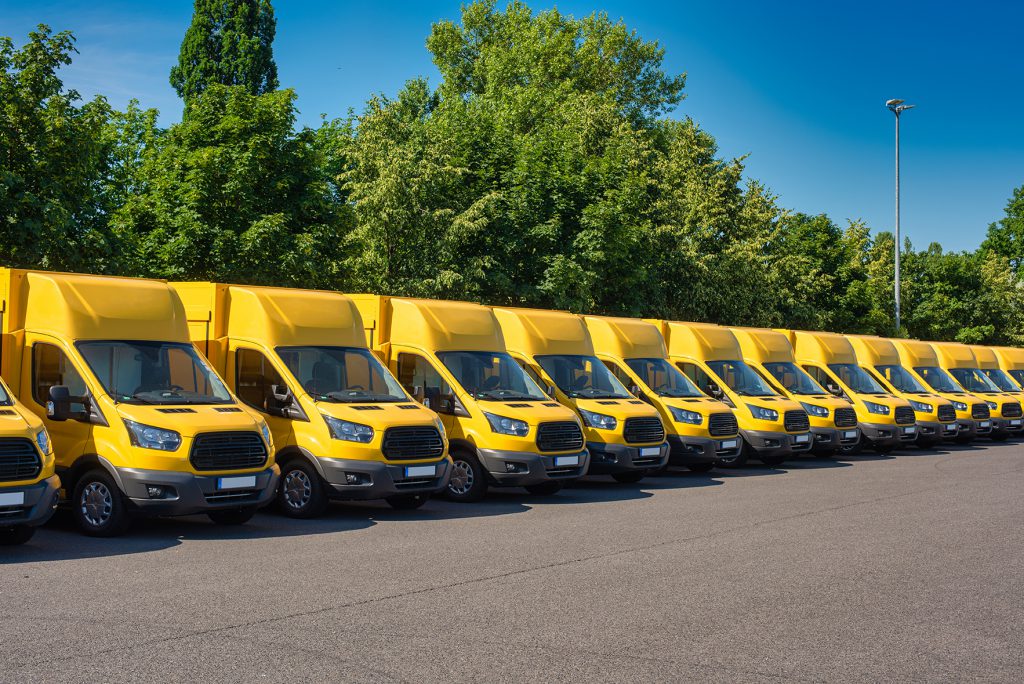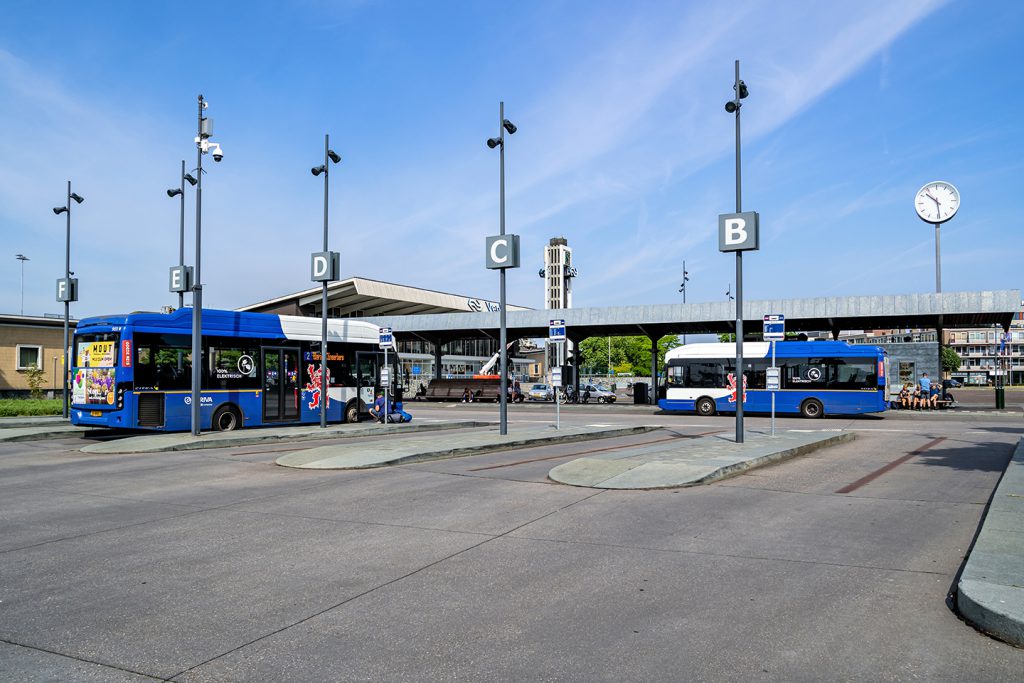
POSITION PAPER
The Revision of CO2 Standards
for Heavy Duty Vehicles

AVERE strongly welcomes the Commission’s initiative to revise the EU’s CO2 standards for Heavy Duty Vehicles (HDV). Lorries, buses and coaches are responsible for about a quarter of CO2 emissions from road transport in the EU, and for some 6% of total EU emissions[1]. Their full decarbonisation is a precondition for the EU’s aim of reaching climate neutrality in 2050.
However, the currently applicable standards are clearly insufficient to meet this goal – in fact, their effect may be offset entirely by increasing road freight activity in coming years[2] – and are already being overachieved by all major European truck makers without significant production volumes of zero-emission HDV[3]. Setting a clear, more ambitious trajectory for the decarbonisation of Europe’s Heavy Duty Fleet, including an ambitious phase-out date for ICE vehicles, will not only provide certainty to industry and help achieve scale and lower purchase cost, but is a precondition for reaching the EU’s climate objectives in the transport sector.
The key enablers for rapid change are in place:
– Fully electric heavy duty vehicles are available to the market, and are rapidly closing in on conventional diesel trucks in terms of their total cost of ownership (TCO) – a key catalyst for transformation in a business usually operating on slim margins and looking for any competitive cost advantage.
– Battery ranges are increasing, allowing for the deployment of electric heavy duty vehicles without the need to significantly modify established operational patterns
– The applicable standards for ultrafast “megawatt charging” are in the process of being finalised, and the proposed Alternative Fuels Infrastructure Regulation (AFIR) will guarantee a minimum coverage of dedicated HDV charging infrastructure along key EU roads.
AVERE therefore calls on the Commission to present an ambitious proposal for reinforced CO2 standards for heavy duty vehicles, including reinforced pre-2030 targets and a phase-out of new non-zero-emissions HDV (including long haul) by 2035 at the latest. Such a trajectory would put the EU’s industry firmly at the forefront of the changing transport and logistics ecosystem of the future, stimulating innovation and creating employment opportunities, whilst guaranteeing the achievement of the EU’s legally binding CO2 targets in the transport sector, reducing the bloc’s dependency on oil imports, and improving citizens’ health by reducing air pollution.
AVERE’s recommendations
1. Cover all heavy duty vehicles under one comprehensive regulation
Currently applicable EU rules set emissions reductions targets for large lorries only, and therefore fail to capture about a third of HDV sales in the EU. However, the EU’s aim to become carbon neutral in 2050 requires the full decarbonisation of road transport, and thus relevant regulatory files have to cover all vehicles on EU roads.
The revision of the heavy duty CO2 standards should therefore include all vehicles, including small and medium lorries, trailers, as well as buses and coaches. Exceptions could at most be considered for niche use vocational vehicles, where electrification is proven to not be technically feasible, subject to regular review.
2. Phase out all non-zero-emissions HDV by 2035 the latest, and urban buses by 2027
Newly sold trucks today will remain on EU roads for many years to come. As of 2022, the average truck in Greece was 21.4 years old, with trucks in Italy having been in service for an average 18.5 years, Estonia boasting an average 17.6 years, and Belgian trucks being 16 years old on average[4].
This means that in order to reach the EU’s aim of having nearly exclusively zero-emission trucks and buses on EU roads by 2050, a phase-out of new emitting trucks is needed by 2035 at the very latest to allow the gradual replacement of the fleet in line with the EU’s goals. Any later date would mean an inevitable failure to decarbonise road transport in time for the EU’s 2050 climate neutrality target.
The electrification of urban buses is already a reality in many European cities. With operational patterns offering themselves to electrification, ample opportunities to recharge either at the depot or en route, a broad variety of models available to the market, and considering their key role in reducing air pollution in city centres, urban buses can and should be decarbonised ahead of the general timeline in 2027 already.
3. Set strong pre-2030 interim targets
Under the current regulation, emissions will have to be reduced by 15% in 2025, followed by a 30% reduction in 2030 – a weak set of targets, which most truckmakers are set to overachieve.
The 2030 target of 30% should thus be brought forward to 2027/2028 as an interim target – a more ambitious, but realistic aim given both expected ZEV sales and efficiency gains in combustion technology. In fact, studies have shown that around 30% ZEV sales can be expected in 2028 under the right legislative framework[5]. For zero-emission urban buses, an interim 2025 benchmark should be set at 60% given the earlier 2027 phase-out deadline.

These interim targets should be followed by a 65% reduction aim for all coaches, lorries and trailers in 2030, as a crucial stepping stone towards a full phase-out of non-zero-emission vehicles five years later. This level of ambition is more than realistic given that ICCT studies indicate that any 2030 target below 60% would not only be incompatible with the legal obligation of climate neutrality by 2050, as enshrined in the European Climate Law, but in fact fall short of existing voluntary manufacturers’ announcements[6].
Such targets are a necessity for Europe’s climate aims, but would also make economic sense: the rapid uptake they would stimulate would allow economies of scale and thus even quicker TCO convergence, and therefore create a self-reinforcing virtuous cycle, with the market increasingly demanding ZEVs over their ICE alternatives. They also will help to wean Europe off its dependency on oil imports – for example from Russia – more quickly.
4. Abolish the ZLEV scheme by 2027
The current regulation allows relaxations to their targets for manufacturers who sell a certain share of zero- or low-emission trucks (2% as of 2025). However, this target is set significantly too low given the required major ramp-up of ZEV sales. Furthermore, the mechanism includes hybrids and other so-called “low-emissions” solutions, which still produce tailpipe emissions and therefore cannot make a meaningful contribution to climate neutrality in the medium and long term.
To facilitate the uptake of ZEVs as the only viable solution for fully decarbonised road transport, the mechanism should focus exclusively on ZEVs to encourage their initial uptake, setting a higher benchmark of 10-15% of sales, and eventually be entirely phased out after 2027. After that, the CO2 standards themselves should be the sole driver of emissions reductions as market shares of zero-emissions drivetrains rise, as maintaining the ZLEV mechanism in the long term would constitute an effective watering down of the regulation’s effectiveness.
5. Focus on zero-emission powertrains
One recurring discussion in setting vehicle CO2 standards in the EU is whether there should be a pathway for the use of renewable fuels, RFNBOs or even “low-carbon” fossil fuels, for example through dedicated e-fuels accounting schemes.
However, such an inclusion would be a mistake. Those technologies that are not zero-emissions to start with (“low-carbon” options) are incompatible with the EU’s climate aims, while zero-carbon renewable fuels are expensive and sparse. They are more urgently needed in other sectors such as shipping and aviation, as well as for various industrial sectors. They also do nothing to tackle air pollution, and, in the case of e-fuels, constitute a waste of precious renewable energy due to conversion efficiency losses. Furthermore, it may be difficult or impossible to prove if a vehicle really runs on 100% low- or zero-carbon fuels throughout its lifetime, creating serious enforcement problems.

In order to provide investment certainty and prevent loopholes in the regulation, it is thus crucial that the regulation keeps its focus on zero-emission powertrains and does not introduce any mechanisms for fuels crediting.
6. Make larger fleets zero-emissions as a priority
In addition to the more ambitious target trajectory outlined above, a dedicated mandate for the biggest corporate HDV fleet operators to decarbonise their fleet ahead of this timeline – for example by 2030 already – should be considered.
Larger corporations could send a strong signal for the deployment of zero-emission trucks to the overall market. They tend to be more able to make the required upfront investment than SMEs, and could have a disproportionate positive impact by sheer virtue of their size and resulting emissions share in wider heavy duty road transport. A clear zero-emissions procurement mandate could also help ensure that second-hand vehicles are available earlier to smaller and less financially stable SME market players. Lastly, such a measure would also be helpful in matching manufacturers’ announced ambitions on the supply side with guaranteed demand, giving them security in planning the ramp-up of their ZEV production.
In fact, corporate fleet mandates would match and reinforce existing corporate initiatives: major market players such as Amazon have already announced plans to deliver a significant share of their deliveries emissions-free by 2030[7].
7. Include a straightforward credit trading scheme between manufacturers
Under the CO2 standards for cars and vans, a “pooling mechanism” currently allows manufacturers to “pool” their obligations with other manufacturers, allowing for flexibility in achieving fleet-wide targets while safeguarding the overall ambition of the regulation.
While a comparable mechanism would not be appropriate for heavy duty vehicles due to the limited number of major manufacturers in the market and complexities coming with pooling procedures, a straightforward credit trading system should be established instead. Such a system would provide an additional cost-effective compliance option for manufacturers with fewer resources, while allowing to maintain the necessary ambitious target trajectory.
8. Create enabling conditions through adjacent files
AVERE is convinced that Europe can set the most ambitious heavy duty CO2 standards worldwide, and thus make itself a global leader – both industrially and in terms of the fight against climate change. However, this requires a variety of flanking measures in other key files.
Notably, the AFIR should set ambitious targets for HDV charging on the TEN-T core and comprehensive network, in urban nodes, and in safe and secure parking areas. The EPBD, on the other hand, should be amended to include requirements for logistics hubs, distribution centres and freight depots so that heavy duty vehicles can easily charge during their normal operational patterns.
A rapid reinforcement of electricity grids across Europe is needed to support high-power charging for electric heavy-duty vehicles. The European legal framework, including state aid guidelines, should be revised to this end.
Major investments are needed in re- and upskilling to ensure a just transition in truck manufacturing, as well as ensuring the availability of qualified installers to set up the needed charging infrastructure network.
With regards to urban buses and municipal service fleets, the demand side should be taken into account, setting higher targets in the Clean Vehicle Directive, as an important tool to drive down prices.
[1] https://ec.europa.eu/clima/eu-action/transport-emissions/road-transport-reducing-co2-emissions-vehicles/reducing-co2-emissions-heavy-duty-vehicles_en
[2] https://theicct.org/wp-content/uploads/2022/03/hdv-co2standards-recs-wp-mar22.pdf
[3] https://www.transportenvironment.org/discover/eu-truck-targets-too-weak-to-incentivise-the-production-of-enough-zero-emission-vehicles
[4] https://www.acea.auto/files/ACEA-report-vehicles-in-use-europe-2022.pdf
[5] https://www.transportenvironment.org/discover/eu-truck-targets-too-weak-to-incentivise-the-production-of-enough-zero-emission-vehicles
[6] https://theicct.org/wp-content/uploads/2022/03/hdv-co2standards-recs-wp-mar22.pdf
[7] https://sustainability.aboutamazon.com/environment/sustainable-operations/shipment-zero

